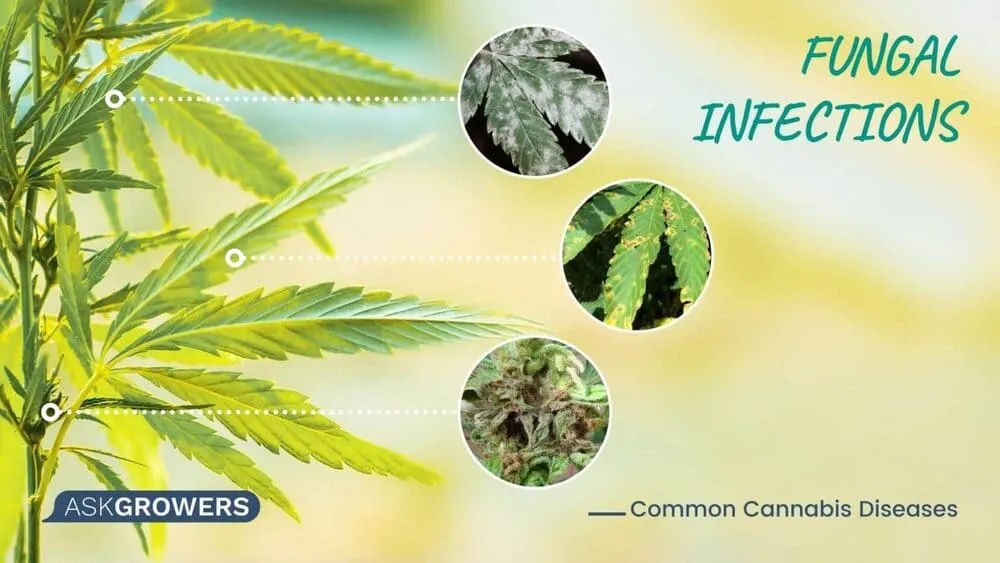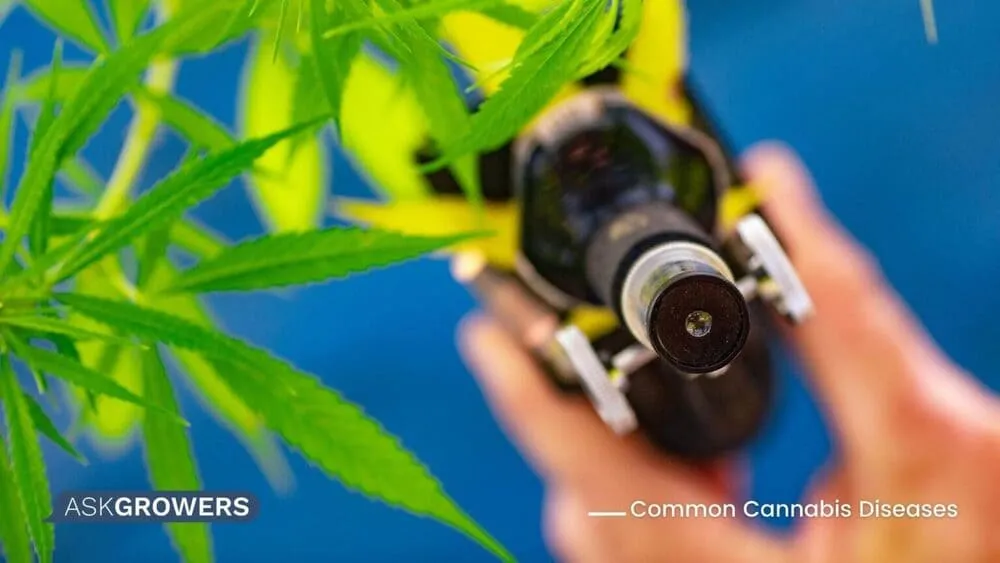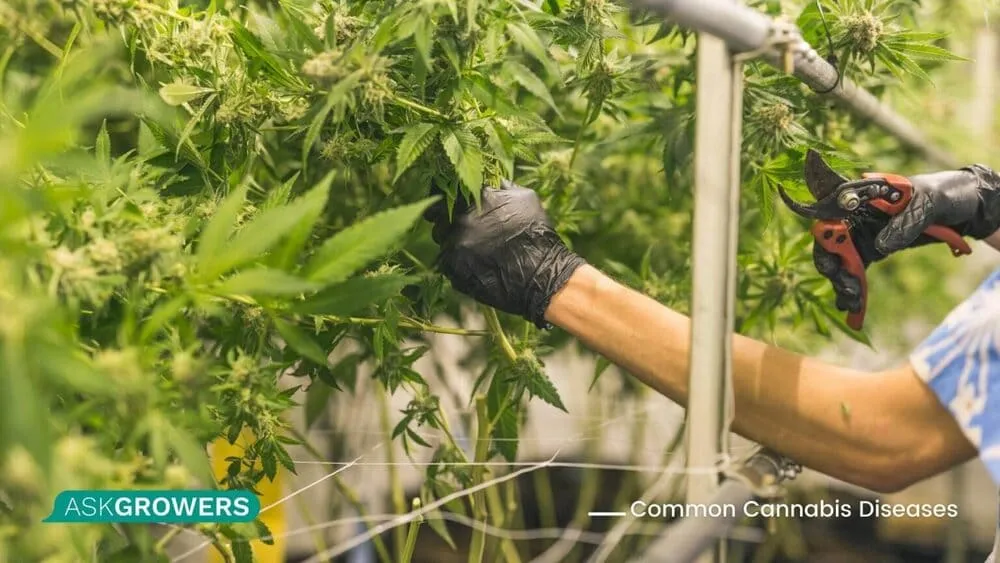Cannabis is a multifaceted crop that sources communities with textile fiber and food and has diverse medicinal applications. Its cultivation areas are increasing worldwide. Though, large-scale cultivation faces various challenges, including microbial infections and virus outbreaks. Weed diseases are a serious threat that can significantly damage crops and cause farmers to lose their money, effort, and time. This article highlights the most typical pathogens, which cause marijuana diseases, and how to diagnose, treat, and prevent them.
Common Cannabis Diseases
All marijuana diseases are typically affected by microbes that belong to the category of:
- Fungi
- Viruses
- Bacteria
Also, they can be categorized based on the infected plant zone:
- Root and crown
- Foliar and stem
- Inflorescence
- Post-harvest pathogens
Below is a brief description of the most devastating and commonly occurred phytoviruses and pathogens.
Fungal Infections
Eachtype of fungi affects plants differently, but most of them are caused by poor ventilation and excessive humidity in the cultivation areas. The most common fungi are:
- Powdery mildew. It is one of the typical cannabis leaf diseases that can occur when plants grow too close together with no sufficient airflow. The fungus forms circles on top of the leaves and looks like a coating of white powder. It is very sneaky, and its spores can live in the soil; however, the disease is reversible if caught early.
- Downy mildew. Weed leaves become weak, turn rusty, and finally dry off.
- Leaf Septoria. This fungus attacks marijuana leaves and stems and results in orange batches on the leaves that can turn into brown spots. Usually, it appears on outdoor plants after they are exposed to sunlight and recent rain.
- Pythium. It appears in the substrate and affects the plant roots during the germination cycle. The stems narrow and become too weak to grow.
- Fusarium. This fungus lives in the substrate and damages the plant stem. It causes root rotting and vascular withering. It may lie dormant in the soil, waiting to strike.
- Algae. This fungus has similar light and water requirements as cannabis and lives on the plant roots, depriving it of nutrients. Make sure that no light reaches the roots. You can block it out with dark material.
- Botrytis. This fungus is one of the most harmful infections because it can eat every plant part and spread rapidly. It causes weed buds to rot and flowers to turn gray or brown. The rot at the base of the leaves and drying leaves are also a sign.

Almost all cannabis vegetative stage common diseases caused by fungi have similar prevention methods. Gardeners have to control humidity, ventilation, and air temperature. Keep all tools clean. Immediately remove infected plants areas and excess foliage. Spray plants with organic fungicides and keep them monitored. In worst cases, farmers may need to harvest early.
Bacteria Infections
Bacteria affect weed plants by causing small lesions that lead to the leaf and stem withering and rotting. The most common bacteria are:
- Xanthomonas campestris
- Erwinia amylovora
- Erwinia carotovora ssp. carotovora
- Pseudomonas cichorii
- Agrobacterium tumefaciens
The best treatment is to prevent these bacteria and use the same products for fungus infections.
Viral Infections
Viruses can reduce plant growth, affect the yield, and cause severe harvest losses. Many viruses can affect plants, but these typically invade marijuana crops:
- Hemp streak virus
- Hemp mosaic virus
- Cucumber mosaic virus
- Apple mosaic virus
- Tobacco mosaic virus
- Alfalfa mosaic virus
- Arabis mosaic virus
- Phytoplasmas
- Hop latent viroid
- Hop stunt viroid
The most common symptoms caused by viruses are green/yellow mosaic patterns on weed leaves and curling and narrowing of young leaves. Viral infections can spread to other plants by infecting mother plants, cuttings, and seeds. According to a study, they can spread through contaminated equipment, tools, and the hands of people working in the garden.
Viruses can only be diagnosed in a laboratory.

Since molecular analysis requires money and time, the cheaper solution will be to burn the plant or focus on preventing this disease. Avoid planting seeds and cuttings of unknown origin, or plant them away from your crop unless you can be sure they are healthy.
How to Prevent Marijuana Plant Diseases
Weed diseases can be controlled by preventing the infection introduction and symptom development and reducing the pathogen’s survival and spread. You can use the following approaches to prevent different marijuana plant diseases:
- Make sure that all cannabis-growing facilities are clean and sanitary.
- Sanitize tools, air filters, and other equipment; sterilize drying areas.
- Use air purification systems to decrease pathogens.
- Maintain appropriate air circulation, humidity, and temperature.
- Use drip irrigation instead of overhead and make a watering calendar.
- Provide the appropriate lighting.
- Treat irrigation water using chlorine or UV to avoid root rot.
- Use new substrate for all plants.
- Limit visits of other people to your garden, especially cannabis growers.
- Keep pets away from the plants.
- Avoid tobacco use at the workplace.
- Use disease-free weed cuttings and ensure that the plant material is inspected for diseases.
- Remove and destroy any infected plants.
If cannabis plants are adequately treated, they are unlikely to show any signs of disease.

You can use preventive compounds before the flowering period starts to minimize the probability of getting infections. You may resort to organic products or opt for chemical remedies, using them only during the growth stage.
How to Apply Plant Treatment
If you spot a disease sign, the first step is to diagnose it. Marijuana plant diseases and symptoms should not be confused with nutritional disorders. A wrong diagnosis leaves a problem unsolved, while resources and time are wasted.
Some plants can be treated using organic methods, while more aggressive infections require heavy-duty fungicides. Isolate your plant if you notice any signs of disease and remove all affected parts. Dispose of these parts so that the spores won’t spread.
Nearly 90% of all products recommended for treating marijuana plants should be diluted in water and sprayed on the leaves. It should be done during dark hours to prevent leaf burns. Apply products with safety and follow instruction guidelines. If you treat indoor plants, turn off the ventilation system for better efficiency and turn it on 2 hours before the lights are on. Two-three days later, spray the plants with pure water to remove the product leftover.
Conclusion
As explained in this article, multiple diseases can affect weed plants, causing total or partial harvest loss. Rest assured that the modern market offers a variety of organic products and chemical remedies to cope with this issue. If you grow weed from seeds and maintain a clean growth environment, disease outbreaks are unlikely to happen; however, breeding cannabis from clones may risk an imported infection. Most growers who follow the basic cultivation practices and horticultural recommendations are rewarded with a healthy and bountiful crop.

